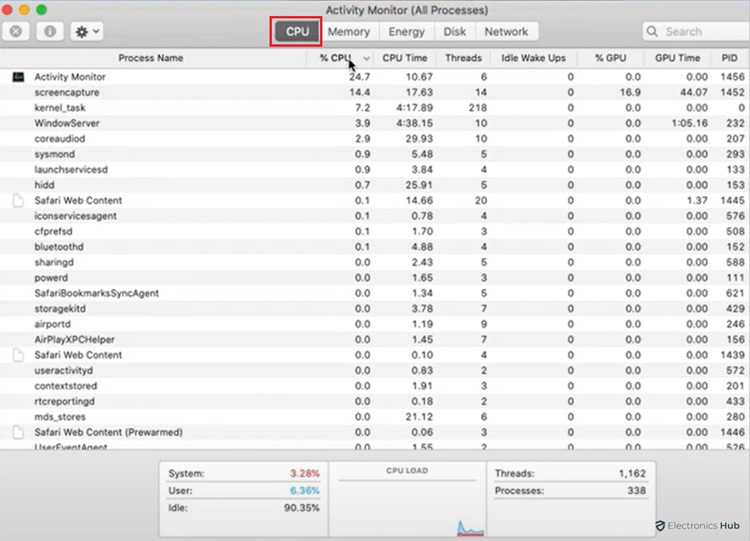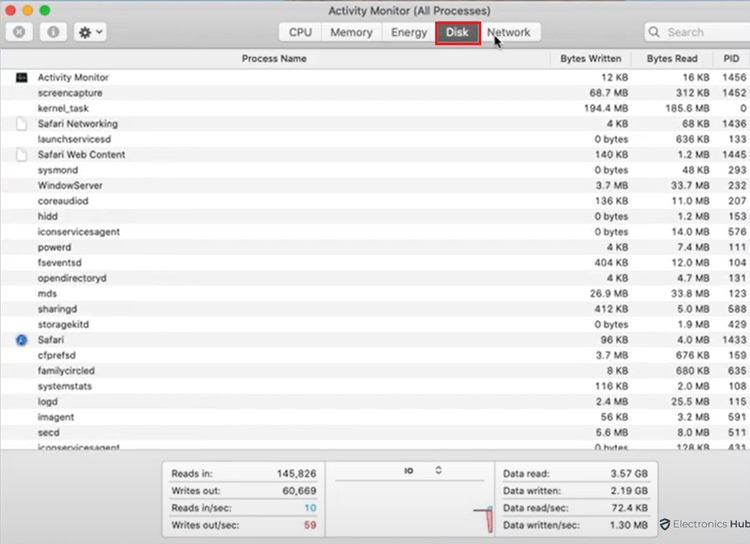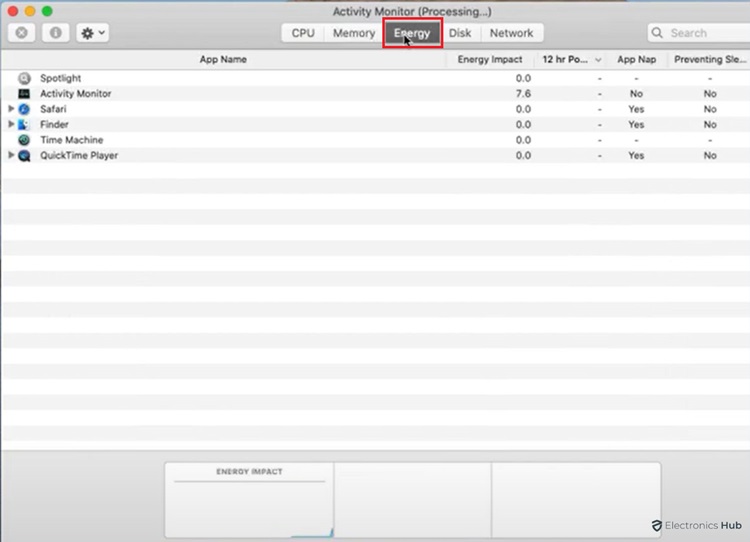Imagine working on a crucial project on your MacOS device, with a tight deadline. Under the increasing intensity of work, you suddenly notice your system is slowing down. If you are a new user of the MacOS device, the basic instinct will be to hit the Ctrl+Alt+Del keys to open the task manager. Don’t be confused if the task manager fails to open on the MacOS device as it offers the Activity Monitor, similar to the task manager.
The Activity Monitor application offers complete monitoring of the system’s active processes, to the user. Similar to the Task Manager, the Activity Monitor can check the process that creates a load on the system or runs inefficiently. Some of the users of MacOS X are not aware of how to access the Activity Monitor. Fear not since this article will guide you through the process of using the MacOS X task manager (Activity Monitor).
Outline
ToggleActivity Monitor On MacOS X
We should be aware that MacOS X does not have a Task Manager. Instead, it uses an application called the Activity Monitor which works similarly to the Windows Task Manager. This application can offer details like the memory consumed by a certain process. It helps in identifying which app or program is running in the background, even if the user has closed them.
Users can use this data to close these applications, to ease the load on the Mac operating system (MacOS X). The Activity Monitor includes different sections that offer details on specific factors like Memory, Disk, Energy, Network, CPU, and Cache. In short, the Activity Monitor can be used to perform various functions.
Why Is Activity Monitor Is Useful
- It helps in identifying the unresponsive processes and applications of the system. After identifying them, users can simply stop them to free the system. This helps in improving the performance of the system
- When you have to monitor the energy consumption of the system, this application comes to your rescue. It can track which process or program is using the highest energy. This data helps minimize energy consumption and also detect abnormalities with the programs
- The real-time monitoring of the CPU helps in understanding the bottleneck of the system during multitasking. Users can also view the network’s status to check which process or program is getting the topmost priority
With this data, you can troubleshoot performance-related issues.
How To Open Task Manager (Activity Monitor) On MacOS X
Being a part of the MacOS X, accessing Activity Monitor is a bit different than a Task Manager. You cannot just press the Ctrl+Del+Alt keys to open Activity Monitor. However, users can open this application by using different alternatives. These alternatives are simple and offer quick access to the Activity Monitor.
Using Finder
- The Finder is available on the MacOS Dock. When you click on the finder, you can select the Applications option from the sidebar
- When the Applications window opens up, you have to choose the Utilities options
- Several icons of apps will appear on the screen. You have to locate the Activity Monitor app icon and double-click it
- This will open the Activity Monitor on your screen
Using Spotlight
You can use Spotlight on your MacOS devices to find different apps, files, and other data. Hence, finding the Activity Monitor will be a piece of cake.
- You have to press the Command and Space keys simultaneously to open the Spotlight
- Type “Activity Monitor” and its icon will come up in the Spotlight search
- You can open it by clicking it or pressing the Enter key
Using Dock
If the above-mentioned options are not working in your favor, you can set up Activity Monitor on your system’s Dock. With the help of Dock, it becomes easy to access the Activity Monitor with just a one-click shortcut. Before adding Activity Monitor to the Dick, you have to either perform the Spotlight or Finder method. This will load the Activity Monitor on the dock.
- By right-clicking its icon on Dock, you have to choose Options
- Here, select the “Keep in Dock” option
- The Activity Monitor will remain in the Dock even after quitting it
Using The Task Manager (Activity Monitor)
Now that we have made arrangements to quickly access the Activity Monitor, you can begin to check the system’s data. As specified earlier, the Activity Monitor can provide diverse data related to the system. You can use it for the following activities:
To Monitor CPU Usage
When you open the Activity Monitor, the first tab shows a list of the currently running processes. These processes use a portion of your Mac system’s CPU, which is displayed in percentages. It gives you an idea of which process is eating up the CPU with more usage.
- Activity Monitor offers an option to sort the CPU usage from higher to lower percentages
- Users can click on the View option and select All Processes
- By clicking on the %CPU column, the data is rearranged
- Any irrelevant process can be shut down from here
To Monitor RAM Usage
The next tab in the CPU usage section shows RAM usage. It simply offers data like how much RAM is being allotted to the multiple processes. RAM directly affects the data transfer speed for temporary files which decreases or increases the performance of your system. When irrelevant processes are consuming a high amount of RAM, the system will lag and experience lowered performance. Users also get an idea if their current RAM capacity is enough or not.
To Monitor Network Activity
The network is a crucial factor for the MacOS X system since it helps in connecting different devices. The Activity Monitor thereby offers data on the system’s network activity. This helps in monitoring the processes or applications that are using a higher percentage of networks. If irrelevant processes are using a higher chunk of networks, you won’t be able to enjoy tasks like online gaming or video streaming.
To Monitor Disk Activity
The disk activity might not be a regularly needed data but it is still a crucial one. It tells us how the disk works during certain processes. The data transfer or rewriting process has a set pattern which shows that the system is normal. If the system is infected with malware or virus, the disk activity becomes abnormally high. This indicates that the disk is being accessed even when the system is idle. You can stop or track the activities to prevent overuse of the disk.
To Monitor Energy Usage
Energy consumption is an important factor if you are using portable systems like MacBook. Even with wired systems like Macs, energy consumption affects the running cost of the system. Higher energy consumption leads to higher bills. Hence, processes that drain the battery or use high power need to be identified.
Activity Monitor offers the Energy Usage tab where energy consumption is displayed for each process. If you find any unnecessary processes or apps here, simply quit them to save energy.
To Monitor Processes
The Activity Monitor allows a detailed perspective of a selected process, to the users. This helps in understanding which factors are being utilized by the process or app. Users can view the CPU usage, RAM usage, and even minor details like the running time of the process.
- To access this section, users have to select the process and press the I + Command keys
- They can also select the Inspect Process option in the view section
- The inspection box will provide you with all the necessary details
Force Quit Applications
There are some stubborn processes or apps that keep on running even after closing them from the Activity Monitor. This can frustrate you as you cannot keep ending them at frequent intervals. Thanks to the Force Quit option, these annoying apps or processes can be shut down. Force Quit thereby becomes an ideal option to optimize your system’s performance.
Method 1:
- To force quit an application, you have to first open the Activity Monitor via Dock, Finder, or Spotlight
- Then scroll to the Memory or CPU usage tab to locate the culprit processes or apps (you can locate them by viewing the percentage usage of CPU or Memory)
- Click on these processes or apps to highlight them
- By clicking the X icon on the toolbar, confirm the force quit process
Method 2:
- Users can also press the Esc+Command+Options key and highlight the app
- By clicking the Force Quit option at the bottom Newof the window, the Force Quit process will be initiated
Alternatives For MacOS Task Manager (Activity Monitor)
There is no doubt that Activity Monitor is the best equivalent of Task Manager for your MacOS device. However, if you need a certain customization while viewing the data, there are several alternatives to choose from. These alternatives are safe to use and offer a deep monitoring of system-related data.
iStat Menus
iStat Menus has a user-friendly design to allow quick updates of the system. It works directly on the menu bar where the data related to CPU, memory, etc is shown in real-time. All the types of data are sorted and displayed in the form of graphs. Users can keep track of this data without having to access the Activity Monitor.
CleanMyMac X
The CleanMyMac X app is an official alternative, approved by Apple. It also offers a quick overview of factors like memory to help you optimize the system. After Installing this app, you can configure it to show memory-related details within one click. Apart from monitoring the memory, it also offers services like freeing the memory space.
Memory Cleaner
Memory Cleaner also offers a one-click solution for memory management. It is a free tool that displays all the apps and processes running on your system. It offers services like clearing RAM with just one click. It also offers direct access to memory usage with one click. Being displayed on the menu bar, users won’t have to scroll through different sections to activate this tool.
FAQs
Ans: The Task Manager is only found on the Windows operating system. You can find the Activity Monitor which is similar to the Task Manager for MacOS. To open this application, open the Finder on your MacOS device. In the Applications tab, select the Utilities option. A new window will open where Activity Monitor is seen on the screen. By double-clicking the app icon, you can open it.
Ans: Even when Activity Monitor is considered the best application for MacOS, you can find different alternatives. Tools like iStat Menus, CleanMyMac X, Memory Cleaner, etc. are popular alternatives for Activity monitors. They offer detailed monitoring of various aspects of the MacOS system. Users also get additional features like one-touch activities along with monitoring.
Ans: Instead of quitting a single process one by one, you can stop all the processes or apps via Activity Monitor. Users can select multiple processes or applications and close them at the same time. However, quitting all the processes will cause problems for your system. The reason behind this issue is that the system-related processes will also close with other processes. This will create instability in performance and restrict the functioning of the system
Ans: The Activity Monitor can show currently running programs on the system. It also offers detailed data like memory usage, CPU usage, network usage, energy usage, etc, related to these processes or programs. Apart from displaying this information, the Activity Monitor can close unnecessary processes or progress to ease the load on the system.
Conclusion
Task manager is a crucial tool to manage the process of your system. Its equivalent, the Activity monitor also smoothly handles the background processes on MacOS systems. The crucial data displayed on the Activity Monitor helps in managing the priority over certain processes. This can help in optimizing the resources like CPU, memory, etc for important processes. This article gives you an overview of Activity Monitor and explains different aspects of this application. This discussion will help you use this application on MacOS devices, without needing the Task Manager.





